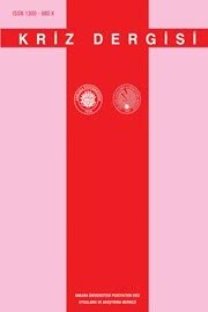EŞIK-ALTI DEPRESYON VE DEPRESİF BOZUKLUK: GENEL MEDİKAL VE MENTAL SAĞLIĞA ÖZGÜ HASTALARIN KLİNİK ÖZELLİKLERİ
Amaç: Yazarlar, ayaktan hasta örnekleminde, depresif bozukluk eşiğinin altındaki depresif semptomların klinik önemini incelemişlerdir. Metod: Hastalar, 775 mevcut depresif bozukluğu olan hasta, 1420 eşikaltı depresyonu olan hasta, 1767 depresyonu olan ve olmayan hipertansif hastalardan oluşmaktadır. Bunlar, psikiyatristler ve genel medikal uzmanlar tarafından görülmüş olan kişilerdir. Demografik özellikler, depresyonun şiddeti, psikiyatrik ve medikal komorbiditenin dağılımı, soygeçmiş ve tedavi öyküsü açısından depresif bozukluktu ve eşikaltı depresyonlu hastalar karşılaştın/mistir. Sonuçlar: Soygeçmişlerinde depresyon olan eşikaltı depresyonlu hastaların yüzdesi (%41), depresif bozukluktu hastalarınki kadar (%59) yüksektir. İki hasta grubunda da medikal ve psikiyatrik komorbidite benzer düzeylerdedir. İstisna olarak, depresif bozukluktu hastalarda anksiyete bozuklukları daha fazladır. Genel medikal sektördeki hipertansif hastalarda, eşikaltı depresyonu olanlar, htindeprese hipertansif hastalardan çok depresif bozukluğu olanlara benzemektedir. Genel medikal sektörde eşikaltı depresyonlu hastalara daha az tedavi uygulanırken, mental sağlık sektöründe her iki durumun da tedavi oranları benzerlik göstermektedir. Tartışma: Eşikaltı depresyon, bir affektif bozukluk varyantı olarak görülmektedir ve mental sağlık sektöründe tedavi edilirken, genel medikal sektörde tedavi edilmemektedir. Bulgular, eşikaltı depresyonlu hastalarda tedavi sonuçlarının çalışılmasının önemini vurgulamaktadı
Objective: The authors examined the clinical significance of depressive symptoms below the threshold for depressive disorder in outpatient samples. Method: The subjects were 775 adult patıents with current depressive disorder, 1,420 patıents with subthreshold depression, and 1,767 hypertensive patıents with and without depression, ali of whom were visiting the offices of mental health specialists and general medical çare providers in three U.S. cities. Data on demographic characteristics, severity of depression, extent of psychiatric and medical comorbidity, family psychiatric history, and treatment history tor the patients with depressive disorder and those with subthreshold depression were compared. Results: The percentage of patients with subthreshold depression who had a family history of depression (41%) was nearly as high as that of the patients with depressive disorder (59%). The two groups of patients had similar levels of medical and psychiatric comorbidity except for anxiety disorders, which were greater among the patients with depressive disorder. Among the hypertensive patients in the general medical sector, those with subthreshold depression were more similar to those with depressive disorder than to the nondepressed hypertensive patients. Treatment rates were considerably lower for patients vvith subthreshold depression than for patients vvith depressive disorder in the general medical sector, but they were similar in the mental health specialty sector. Conclusions: İn these outpatients, subthreshold depression appeared to be a variant of -affective disorder and was treated as such in the mental health specialty sector but not in the general medical sector. The findings emphasize the ımportance of treatment outcome studies of patients with subthreshold depression.
- ISSN: 1300-980X
- Başlangıç: 1992
- Yayıncı: Ankara Üniversitesi
Sayıdaki Diğer Makaleler
RUH SAĞLIĞI SORUNU OLARAK ŞİDDET
GAZETELERDEKİ İNTİHAR HABERLERİNİN OKUYUCUYA NASIL YANSITILDIĞINA İLİŞKİN BİR ÇALIŞMA
R. PALABIYIKOĞLU, Semra AZİZOĞLU, Seda HARAN, Hülya ÖZAYAR
İNTİHAR DAVRANIŞI VE KİTLE İLETİŞİM ARAÇLARI
YAŞLILIK-NARSİSİSTİK KRİZLER VE İNTİHAR
Nesrin KOÇAL, Behçet COŞAR, Selçuk CANDANSAYAR, Zehra ARIKAN, Erdal IŞIK
İNTİHAR GİRİŞİMİ OLAN KADINLARIN DUYGULARINI AÇMA DAVRANIŞI
İNTİHAR GİRİŞİMLERİNDE ÜMİTSİZLİK VE DEPRESYON
Hüseyin HOLAT, Verda BİTLİS, Nesrin DİLBAZ, Tunga TÜZER, Göksel BAYAM
